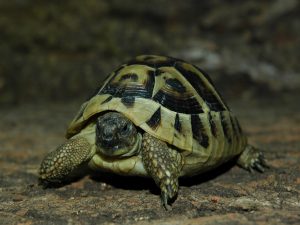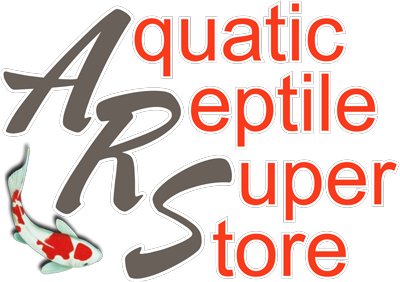Hermann’s Tortoise
Testudo hermanni

Hermann’s Tortoises are native to Mediterranean countries, such as Greece and Italy. This species of Tortoise is docile but will bite in self-defence.
They usually roam about in forests, scrubland and hillsides and are becoming more and more scarce in the wild. Hermann’s Tortoises come in two subspecies. These are the Eastern and Western subspecies, and it often difficult to tell them apart.
They both have the same colouration, but the Western variety tends to have a higher domed shell.
In both subspecies, it can take several years to be able to tell apart the Males from the Females. Males are generally smaller but with longer, thicker tails. The Females have a flat plastron (underside), while the Male’s is more concave.
Latin Name: Testudo hermanni
Difficulty Level: Beginner
Temperament: Docile
Life Span: 20 Years Plus
Size: 6 – 8 Inches
Habitat: Mediterranean – Rocky Hillsides, Forest, and Scrubland.
Diet: Vegetables. Leafy Greens, and a variety of Weeds and Flowers.
Supplements: Calcium, Vitamin D.
Hours of Activity: Diurnal – Hermann’s Tortoises are most active during the daytime.
Handling: You can handle this species, but not too often. This species prefers to be able to feel the ground beneath its feet.
Temperature:
20°C – 25°C Ambient day time temperature.
Up to 35°C Basking temperature.
15°C – Minimum ambient night time temperature.
Humidity: 25% – 35%
Vivarium Size: 48″ x 24″ x 24″ (Minimum).
Substrate Type: Bark, Sand, Soil – Ensure the substrate is deep, as Hermann’s Tortoises enjoy digging.
Equipment Necessary: Vivarium / Enclosure, UVB Lighting, Heat Lamp for the basking area, Thermometers.
Cleaning Instructions: Spot clean any waste and uneaten food daily. Clean the enclosure every week with tortoise-safe disinfectant, replace any befouled substrate.
Healthy Behaviour: Feeding well, exploring its enclosure.
Sick Behaviour: Unwillingness to feed, not passing waste – or less than usual, lethargy, hissing, scratching, making squeaking or whistling sounds.
Add a sunken, shallow water tub for the Tortoise to drink from and wallow in. Giving the Tortoise a bath in tepid water twice a week will help encourage it to pass waste.
Add “Safe to eat” plants to the enclosure for a more natural aesthetic, and a cave for the Tortoise to hide and sleep in.
Don’t house more than one in the same enclosure. They can get stressed and bite each other if their space is too confined.
Hibernating: Hermann’s Tortoise is a species that hibernates naturally in the wild, over the winter months. It is not recommended to allow your Tortoise to hibernate in the UK, as our weather is colder than their natural habitat. This makes it difficult to maintain a stable temperature that falls within the Tortoise’s comfort range.
If you do decide to allow your Tortoise to hibernate, make sure it is in good condition with plenty of fat reserves. You should check this regularly from around early September to ensure your pet can safely make it through. It is recommended to consult a vet before hibernation so that a health check can be carried out.
In the weeks prior, gradually start reducing the ambient temperature to try and mirror the winter conditions of the Tortoise’s natural habitat.
The temperature should be between 3°C and 5°C while hibernating. Be sure never to allow the temperature to drop below 3°C or approach close to 10°C.
Hibernation usually lasts 6 – 10 weeks in adult specimens, and 3 – 6 weeks in younger animals. Keep them safe in a hibernation box away from any noise or activity so as to not disturb them. This can be in a dedicated room, a shed, a garage, or even a fridge (with the correct temperatures set).
In the period leading up the hibernation, the Tortoise will eat less and less until it stops eating entirely. You should allow enough time for the digestion and defecation of its last meal. If not given enough time, the food can begin to rot inside the Tortoise’s stomach and potentially be fatal. This is around 3 weeks between the last meal and the start of hibernation.
Hibernation usually happens around the middle of November and ends in January or February.
Common Problems:
Metabolic Bone Disease – Obvious signs of this are if the Tortoise looks lethargic and is dragging its body, instead of standing proud on its limbs. Also look out for swellings, and bumps along its leg bones. This is avoided by feeding Calcium supplements.
Respiratory Infection – Improper Heating, Lighting and Feeding can cause this. Seek advice from a vet, as they will likely need to prescribe antibiotics.
Cloaca Prolapse – If the bladder becomes blocked with hardened urate due to dehydration, it can cause the cloaca to prolapse. Symptoms include unwillingness to feed, and reduced waste excretion. Contact a vet as soon as possible to get this treated.
Post Hibernation Anorexia – When coming around from hibernation, be sure took keep an eye on the Tortoise’s feeding patterns. If any of the following behaviour occurs, you must seek veterinary advice.
– Not drinking water within 2 days.
– Not eating food within 1 week.
– Failing to urinate within 5 days.
